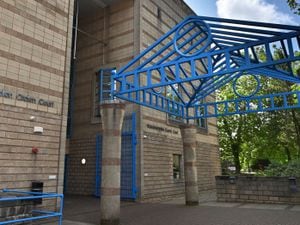IN PICTURES and VIDEO: All aboard! Birmingham New Street station revamp arrives on time
As commuters got on and off the train at Birmingham New Street station each day over the past few years they would have noticed their surroundings gradually changing.
They would have witnessed the station transforming around them and looked up and marvelled at the sparkling shopping complex that was developing above it.
A total of £600 million has been spent on bringing a station that had been stuck in the past into the 21st century.
[gallery]
The station concourse has increased by three times, while a giant atrium will see a station that could once have been accused of being dark and gloomy filled with natural light.
There was agreement from all angles that the station had gone off the rails.
[related_posts title="More on the station revamp"]
Transport minister Simon Burns admitted it was time for a change at New Street, which had remained largely untouched for the past 40 years with its grey exterior resembling that of a multi-storey car park, saying it had 'long had a reputation for being dingy and unwelcoming'.
[youtube][/youtube]
[comments_cta header="What do you think?" text="What are your thoughts on the new-look station?" button="Log in and leave your thoughts below"]
It was decided this needed to change. Almost 35 million people passed through New Street in 2013 and bosses were determined that their first impression of Birmingham after stepping off the train would be bright and glamorous rather than dank and miserable.
[youtube][/youtube]
The £600 million new and improved Birmingham New Street is here and open for business, with the first passengers to be welcomed into the new-look station tomorrow – six years after improvement works first began.
It was in 2008 that the ambitious proposals to transform Birmingham's widely criticised rail station into a state-of-the-art transport hub fit for the 21st century were first revealed.
As a major crossover point for people travelling north and south, New Street is one of the busiest stations in the country, and had long been in need of a facelift.
From Government ministers to councillors and the travelling public, everyone had their say on the station's sorry state.
Today the station concourse is three times bigger to provide room for more passengers. A stunning glass atrium, allowing natural light to flood the station, is the showpiece addition and will greet visitors as they enter.
The wraps have also been taken off new information boards that will help passengers as they make their way around the station, which serves tens of millions of people every year. New automatic ticket barriers have been added to stop fare dodgers.
From the outside New Street has been completely transformed from a tired 1960s eyesore to futuristic transport hub, with space-age mirrored cladding hugging the exterior.
John Lewis announced it would be getting on board with the scheme in 2011, with the high end department store the flagship retailer at the new Grand Central complex, which will open next week.
The 500,000 sq ft development includes major names in fashion, homewares and dining, with Cath Kidston, The White Company, Kiehls and Giraffe among the 60 stores and eateries opening up.
Transforming the station while keeping its thousands of passengers moving every day has not been an easy task.
An army of staff have been working around the clock bringing the station up to standard, with 3,000 workers on-site over the last few months as the development neared completion.
Councillors and business bosses have hailed the 'magnificent transformation' of the station, which they say will be a major catalyst in attracting new investment to the city.[/breakout]
Rather than rushing, heads down, to get out of the station as quickly as possible, city chiefs wanted people to appreciate their surroundings. They are also hoping the new Grand Central shopping centre, due to open next week, will give them a reason to stick around, to go shopping or grab a bit to eat.
Anyone who has spent enough time in Birmingham New Street will attest to feeling like they are trapped in an underground bunker, with the only relief coming when your train finally reaches the chink of light at the end of the station platform.
The only thing that was new about the station was the word that formed part of its name.
But all that is now to change.
The project's main aim was to create a station for people as well as just trains, with chiefs keen to make coming to the station an enjoyable experience in quality surroundings.
Major changes were first mooted as far back as 2002 but it was six years later before a masterplan costing north of half a billion pounds was formally announced.
Grand plans were revealed showing pictures of a stunning, futuristic site that was a million miles from what commuters had become accustomed to.
Bosses promised a station that would 'provide the community with a legacy that reflects the quality, spirit, ambition and commitment of a city that wants to become an international centre'.
Network Rail's Richard Kirkman said at the time: "The main aim of the new design is as much about the movement of people as the movement of trains.
"The old New Street has divided the city centre for far too long and we are aiming to reconnect the city centre by allowing pedestrians to walk through the atrium of the building 24/7."
Project director Chris Montgomery said: "The redevelopment of Birmingham New Street will transform the experience for millions of passengers who use the station every year and allow it to handle the ever increasing number of people who choose to travel by train."
John McNochloas, chairman of transport firm Centro, said passengers in the West Midlands would receive 'the high-quality transport they need and deserve'.
As well as improving the experience for rail passengers, the creation of the new-look station has also created hundreds of jobs in construction and demolition.
Young people from the Midlands have also been provided with a boost, with more than 100 apprentices taken on to work on the scheme.
[interruptor]
[breakout title="The project by numbers shows work completed" align="right"]
4 train operating companies run through the station.
5 times the size of London Eustons concourse.
12 platforms have been refurbished.
13 centre courts at Wimbledon size of the new passenger concourse.
15 new lifts, serving every platform.
36 escalators, serving every platform.
37 A train arrives or departs Birmingham New Street every 37 seconds.
60 per cent of the rainwater harvested from the façade is used to flush all the toilets.
85 per cent of non-hazardous waste material from the whole project to be recycled or re-used as a minimum.
1,000jobs created through John Lewis and Grand Central.
1,200 workers average on-site, increasing to 3,500.
3,300 square metres of atrium the size of a football pitch.
5,000 tonnes of concrete removed from the old NCP car park to create the first half of the new concourse.
7,000 tonnes of concrete removed from Stephenson Tower.
10,000 lorry journeys saved off Birminghams roads by using trains to transport waste material.
20,000 tonnes of concrete removed to create the space for the atrium.
170,000 passengers use the station daily.
200,000sq ft of retail space in Grand Central.
250,000sq ft of space in John Lewis.
300,000 is the passenger-per-day capacity of the new Birmingham New Street station.
[/breakout]
Perhaps the most impressive thing of all is that the overhaul has been delivered by and large to the timescale that was originally predicted, without, as commuters in particular may have feared, major delays.
And bringing the 21st century vision of New Street to reality was no easy task.
Planners were faced with the challenge of completely overhauling the station while keeping it open to the thousands of passengers who pass through it every day.
It has been an impressive achievement to keep the station moving over the past four years as much of it resembled a building site, with passengers encountering only slight inconvenience.
To do this, it was decided that the scheme would be delivered in two parts. The first phase of the development focused on a new west concourse. To make way for it major demolition work was necessary including a multi-storey car park.
Some 7,500 tonnes of concrete was removed from the car park and Pallasades shopping centre, which has now been transformed into Grand Central, clearing the space needed to form the new concourse, complete with escalators connecting to the platforms.
An army of workers have been responsible for transforming New Street with the 1,000 that had been on site every day increasing by three times as the project reached the finishing straight.
Though much work was going on behind the scenes, the demolition of the 22-storey 200ft Stephenson Tower, a landmark building since its construction alongside the 1960s rebuild of New Street station, was one of the first external changes.
Sitting above Platform 12 of the station in the heart of the city centre, demolishing the building via controlled explosion was never an option. The tower was encapsulated in a protective wrap and taken down piece by piece to minimise noise, dust and disruption, with around 7,000 tonnes of concrete were removed from the building.
Mr Osborne was speaking ahead of the launch of the new-look station tomorrow and said the Government was 'committed to building the Midlands engine'.
He said: "This £750 million investment to modernise Birmingham New Street station is at the heart of our plans to use the power of infrastructure to build a more healthy, balanced and productive economy right across the Midlands.
"We are committed to build the Midlands engine, set to boost growth by attracting local jobs and investment."
Transport secretary Patrick McLoughlin said New Street was now a 'truly impressive building.
He said: "The transformation of Birmingham New Street is a prime example of how our record investment in the railways is improving journeys for hardworking people and helping to rebalance the economy by driving growth across the country.
"The improvements made at this important transport hub have made it into a truly impressive building that passengers and the people of Birmingham can use and enjoy."[/breakout]
The same year 8,000 reflective stainless steel panels were added to the station building in an attempt to brighten it up. Before long the shell of the new futuristic frontage became visible as the development gathered pace.
The project's first major milestone was reached two years ago when train passengers began to use the first half of the brand new concourse. The old concourse was then closed to allow work to begin on the second phase of the project. But builders were quickly faced with a fresh challenge after surveys identified significant quantities of asbestos that had to be removed prior to commencing demolition works.
Then, in August 2013 work began to transform the Pallasades into Grand Central. Steadily, the centre began to take shape and bosses behind the development have managed to stick to the timescale for delivery that was set out when work began.
In March this year a stunning 3,300 sq metre atrium, the centrepiece of the station's new era made from the same hi-tech material as the Eden Project in Cornwall, was lowered into place over the new concourse. Tonnes of concrete was then removed from underneath it allowing natural light to stream in through the roof.
The idea behind the atrium was not only to allow a view of the outside world, but also to create an 'an attractive, open retail environment'.
To say there has been change at Birmingham New Street over the past six years would be an understatement. It is no longer somewhere you have to tolerate going to get in and out of the city.
[interruptor]
With a huge new concourse, overlooked by a sparkling atrium the city finally has a station it can be proud of. It is almost enough to make you forget you have got a train to catch.





